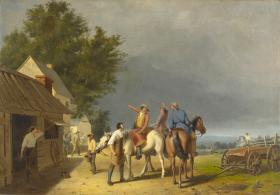
As the defining moment in the history of the United States, the American Revolution quickly acquired the grandeur and aura of a sacred myth, a myth constantly retold and reimagined by artists of the young republic. Most, following the European tradition, depicted the violent birth of the nation as grand opera, its heroes larger than life, their struggles titanic, and their virtues triumphant. (Emmanuel Leutze’s Washington Crossing the Delaware, now in New York’s Metropolitan Museum of Art, is only the most celebrated example.) In marked contrast, William Ranney conceived the Revolution on a less elevated, though no less moral, plain.
First News of the Battle of Lexington is one of a series of paintings depicting scenes of ordinary people responding to extraordinary events. The skirmish between redcoats and minutemen at Lexington on April 19, 1775, signaled the beginning of the War of Independence. However, rather than represent the actual encounter, Ranney turns our attention to the aftermath. An unnamed commentator, possibly the artist himself, describes how “the tidings spread—men galloped from town to town beating the drum and calling to arms. The people snatched their rifles and fowling pieces, and hurried towards Boston. The voice of war rang through the land, and preparations were every where commenced for united action.”
Ranney’s anonymous farmers and tradesmen, rallying to the call of their country, exemplified the collective heroism of Americans. It was no coincidence that the artist’s evocation of selfless courage and patriotism appeared just as the United States was preparing for war against Mexico. In First News of the Battle of Lexington, Ranney created an image of a valiant past to stir a new generation of Americans to glory.

